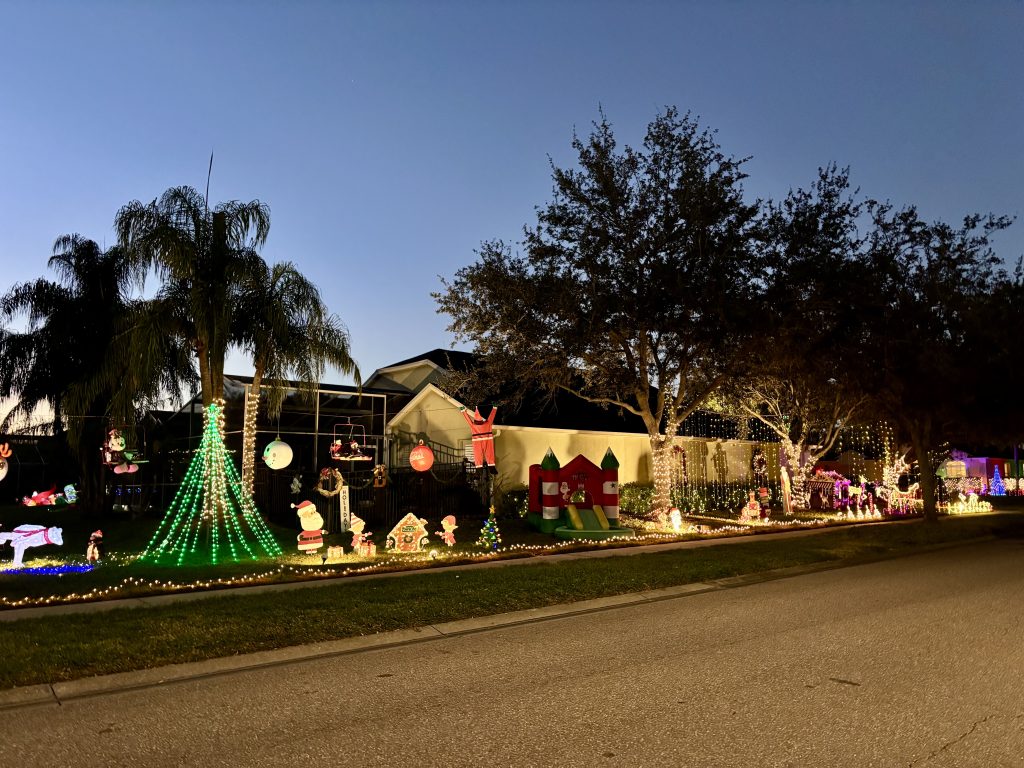We would like to thank everyone who took part in this year’s decorating contest for helping to spread holiday cheer with your beautiful displays! Thank you also to our judges (who will remain anonymous). They definitely had a tough job this year! We had 30 homes participate across four categories and six neighborhoods vying for the Community Spirit Awards. It was a close race in all categories.
Winners are listed below, as well as a list of very worthy honorable mentions. Please note that the contestants selected the category in which they would be judged. Congratulations to all!
This list is a great way for everyone to get out and get in the holiday spirit right here in our community. Happy Holidays!
The Griswold Winner: Pablo Smith, Mandolin Estates
This award recognized the best overall use of lights à la Clark Griswold. Pablo took this challenge literally, draping his entire house, yard and trees in glistening lights to create a display that would make Clark proud. We’re guessing you might actually be able to see this one from space. Location: 11668 Renaissance View Court, Mandolin Estates*

The Martha Stewart Winner: The Digirolamo Family, Harbor Links/The Estates.
The Digirolamo Family captured this award for the second consecutive year. Photos do not do justice to how lovely this display is. We’re pretty sure Martha would approve. Location: 9913 Emerald Links Dr., The Estates*

Deck the Yard Award Winner TIE:
This award focuses on the best use of yard decorations to enhance the overall display. The judges decided it was impossible to choose just one winner, so the award goes to two homes:
The Baugh Family of The Bridges
This display lights up the Lightner Bridge Loop in Wakesbridge and offers interactive fun for the whole family. Enjoy Christmas tunes, holiday movies projected onto the home’s exterior and a mailbox where you can drop your letters to Santa…and he will write back! It is clear that so much love went into this display. Location: 10441 Lightner Bridge Dr in Wakesbridge.

Dan and Robert Good of Woodbay
The Good home is the centerpiece of the award-winning Bristol Commons community display and they always go above and beyond. This year, they outdid themselves when vying for the Deck the Yard prize with a whimsical display complete with giant inflatable Santa hats! Location: 12428 Bristol Commons Circle in Woodbay

Small But Mighty: Brandon and Kerri Lind of West Park Village
This year, we added a new category for our villa, townhome and condo communities with limited yard space, and the entries did not disappoint. The Lind Family made the most of their minimal yard space with an impressive and elegant display that makes their corner of Tate Lane sparkle! Location: 10030 Tate Lane in West Park Village.

Community Spirit Award Winners
Westchase: Bristol Commons Circle in Woodbay
This year, the Westchase award was a very close race with Bristol Commons edging out the Keswick Place cul-de-sac by 1 vote!
Every home along the Bristol Commons Circle participates, with each one letting its unique holiday spirit shine through – whether that is for Christmas, Hanukkah, or the holiday season. It is tied together with zig-zag lights strung from treetops, making a delightful drive for visitors.
We love seeing communities working together to create these magical displays. In addition to Bristol Commons, be sure to check out the Keswick Place cul-de-sac in Keswick Forest and all of the communities listed in the Honorable Mentions section below.

Northwest First Place: Windsor Place
This close-knit townhome community features a selection of unique displays, making for a fun drive through the community’s loop.
Honorable Mentions
The Griswold
-
- Michael Keyles, 9611 Woodbay Dr
- Gordon Price, 10416 Snowden Place
- Matt & Megan Keleshian, 12120 Clear Harbor Dr*
- David Ayow, 9807 Woodbay Dr
- Mark Sawyer, 9905 Bennington Dr
- Josephine Beaumont, 10743 Ayshire Drive
- Walter Allen, 10305 Green Links Drive*
The Martha Stewart
- Martha and Jon Stein, 11810 Marblehead Drive*
- Elizabeth Rommel, 10128 Downey Lane
- Dustin Cullison, 10017 Bennington Dr
- Michael Flannery, 10625 Gretna Green Dr
- Missy Voelker, 10603 Tavistock Dr
- Andree Devove, 10329 Green Links Dr*
Deck the Yard
- The Pivnichny Family, 10306 Seabridge Way
- Rachel Comella, 10206 Rubury Pl
- Bryan and Monika Miller, 10415 Applecross Lane*
- Angela Johnson, 10719 Ayrshire Dr
- Heather Greeley-Hessefort, 10526 Chambers Drive
- Connie Lufkin, 9610 Woodbay Dr
- Noel Family, 10521 Weybridge Dr
- Joel Olinski, 10324 Lightner Bridge Dr
- The Heinemanns, 12014 Wandsworth Dr
Small But Mighty
- Stef Crocco, 12425 Berkeley Square Dr
- Jaime Koren, 12432 Streamdale Drive
- Carole DeJohn, 9838 Gingerwood Drive
Community Spirit
- Keswick Place cul-de-sac, in Keswick Forest off Countryway Boulevard
- Seabridge Way cul-de-sac in Baybridge
- Lightner Bridge Drive in Wakesbridge
- 10030 Brompton Drive cul-de-sac in West Park Village
*Houses with an asterisk are in gated communities.




